
 |
see all our photos from WGT 2003 here
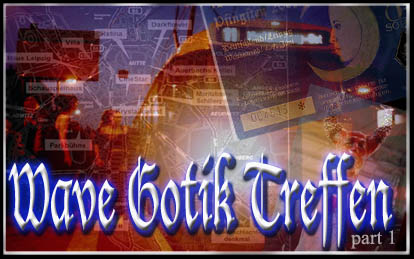
Wave Gotik Treffen June 6 - June 9, 2003 Leipzig, Germany ~review and photos by Uncle Nemesis (photos of Uncle Nemeis by Bunny Peculiar) PART ONE:
How shall we begin? Let me give you a few statistics. 141 bands. 15 venues. 20,000 goths. Four days. One city. One festival. You think the Whitby Gothic Weekend counts
as a big event? You think Convergence is about as major-league as the goth
scene ever gets? You figure things are going great guns when your local This, in short, is the big one. This is the Wave Gotik Treffen. The WGT is not a new event. Its origins go back to the late 1980s, when the nearest thing the then Communist state of the German Democratic Republic had to a goth scene was occasional parties and gatherings among friends. At that time, goths were considered to be a genuinely subversive element by the authorities, a manifestation of the decadent west - which, in a way, they probably were. But then, what's wrong with being decadent? However, in the East Germany of the 1980s simply to walk down the street wearing black clothes and an interesting hairstyle was to risk harassment and arrest. The specific event which, in WGT folklore, has become recognised as the beginning of the festival we know today occurred in either 1987 or 1988. The story is a little confused; different sources quote different dates. More than 15 years on, much of the early history of the WGT has become a little fuzzy. That's understandable. After all, it wasn't as if anyone knew, back then, that the event would last so long or grow so large. It wasn't like anyone was sitting around taking notes for posterity. What we do know, however, is this: at some time in the late '80s, a small group of goths decided to get together for a night of partying in the grounds of Belvedere Castle in Potsdam. Word of mouth spread the news, and many more people turned up than anyone was expecting. So did the police. Arrests were made: some of the partygoers ended up in prison. In spite of this (or, perhaps, because of it) the Potsdam castle parties continued for the next few years, still nothing more than informal gatherings, still not a festival in any official sense - but the number of attendees kept on growing, until the event became, more or less by accident, an annual mini-festival attended by a crowd several hundred strong. During this time the rallies and demonstrations which eventually led to the fall of the East German regime were taking place. Goths took part in these, gathering together to form a 'black block', as their involvement became termed, in the marches for freedom. In 1992, with Germany reunited and the
goth scene in the former GDR now able to go overground, the Wave Gotik
Treffen officially began with an event at the Eiskeller club in Leipzig.
This is the Behind the scenes, however, the WGT was still being run in much the same informal manner as the earliest events. As it turned out, a little too informal. In 2000, mid-way through that year's festival, the news broke that the two principal organisers had run off with all the money. The festival came close to collapse, but was saved from outright failure when many of the bands, crews, and security staff elected to carry on with a reduced programme of events, even though they knew they would not be paid. The mayor of Leipzig stepped in and promised funding from the city's coffers to cover the festival's debts - by now, the WGT had simply become too big to be allowed to die. Lessons were learned. From that point on, the organisation of the event was placed on a far more businesslike footing. Today, the WGT is run by a specially created subsidiary company of Inmove, one of Germany's principal festival promoters, and the standard of organisation is as efficient and professional as anyone could wish. The Wave Gotik Treffen of 2000 is, however, still remembered. Old WGT hands refer to it as 'The chaos year'. THE 12th WAVE GOTIK TREFFEN And so to the Wave Gotik Treffen of 2003,
the 12th event in the official timeline since 1992. Here we are, a contingent
of UK-scene goths, flying in to Leipzig on a plane little larger than a
model. Evidence of Leipzig's recent history as
a city in a Communist state is, at first glance, hard to find. Friday morning, the first official day
of the twelfth Wave Gotik Treffen. What better way to start the day than
with an absinthe breakfast? The Sixtina bar, an incongruously gothic edifice
on an Then it's time to exchange our tickets for the wristbands which will allow us entry to the clubs and venues which host WGT events, and also allow free travel on Leipzig's trams. Trams play a big part in the WGT - in fact, the number 11 tram, which links two of the principal venues with the centre of the city, runs all night specially to cater for the WGT crowd. The experience of boarding a tram that's entirely full of goths, in the early hours of the morning, and swaying through the sleeping city on our way back to the hotel, is quite surreal. Naturally, even the overnight goth-special service runs on time.
But the day is moving on. Soon, it'll be
time for what we're here for. Bring on the bands!
...continue
to Part 2
07/18/03 |
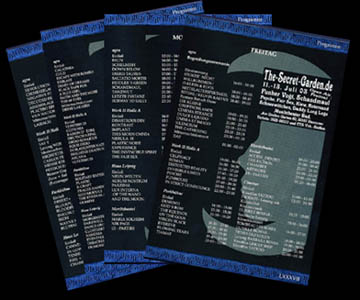 goth
promoter gets 250 people in for a show? Prepare to have your perception
fields adjusted. Allow me to introduce you to the biggest specifically
goth event on the planet. It will demolish all your preconceptions and
replace them with a weird kind of stupefied delight. It will put your tiny
little home-town scene into stark perspective. It will show you what is
*really* possible. It will demonstrate just how far this weird, illogical,
fractious, contradictory scene of ours can go when it cuts the crap and
stamps on the gas. This is what happens when goth really counts for something.
This is shock and awe, goth style.
goth
promoter gets 250 people in for a show? Prepare to have your perception
fields adjusted. Allow me to introduce you to the biggest specifically
goth event on the planet. It will demolish all your preconceptions and
replace them with a weird kind of stupefied delight. It will put your tiny
little home-town scene into stark perspective. It will show you what is
*really* possible. It will demonstrate just how far this weird, illogical,
fractious, contradictory scene of ours can go when it cuts the crap and
stamps on the gas. This is what happens when goth really counts for something.
This is shock and awe, goth style.
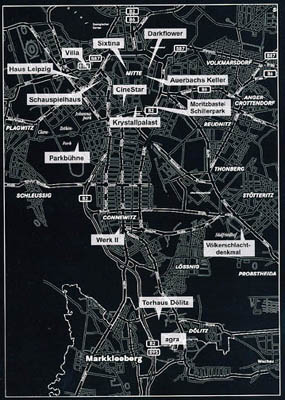 occasion
from which all WGTs to the present day are counted. Even though the festival
was at an embryonic stage, 2000 people attended - twice as many as the
Whitby Gothic Weekend reaches at its peak today. This fact alone illustrates
the great strength of the German scene, and makes the astonishing growth
of the Wave Gotik Treffen in the years that followed entirely understandable.
By the late '90s, the festival had taken on its current form: a four-day
experience during which gigs, club nights, film shows and art events take
place in a variety of Leipzig's clubs, theatres, parks and venues, with
an attendance currently standing at around 20,000.
occasion
from which all WGTs to the present day are counted. Even though the festival
was at an embryonic stage, 2000 people attended - twice as many as the
Whitby Gothic Weekend reaches at its peak today. This fact alone illustrates
the great strength of the German scene, and makes the astonishing growth
of the Wave Gotik Treffen in the years that followed entirely understandable.
By the late '90s, the festival had taken on its current form: a four-day
experience during which gigs, club nights, film shows and art events take
place in a variety of Leipzig's clubs, theatres, parks and venues, with
an attendance currently standing at around 20,000.
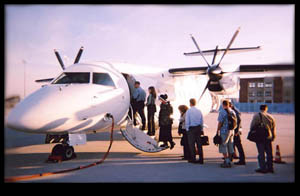 You
can do the WGT in a variety of ways: if you favour the traditional festival
experience, you can bring a tent and claim a space in the campsite. If
creature comforts are more your thing, allow me to recommend the Renaissance
Hotel, one of many international chain hotels which piled into Leipzig
as soon as the border was swept away and the new market of the east opened
up. Leipzig has always been an international city. Even during the Communist
era, it was a major location for trade shows and conferences - although
at that time, of course, the attendees were drawn only from Eastern Bloc
countries. Now, Leipzig is making a big play for worldwide status in this
area. English, the common language of the world, is everywhere. Even the
tram timetables are bilingual.
You
can do the WGT in a variety of ways: if you favour the traditional festival
experience, you can bring a tent and claim a space in the campsite. If
creature comforts are more your thing, allow me to recommend the Renaissance
Hotel, one of many international chain hotels which piled into Leipzig
as soon as the border was swept away and the new market of the east opened
up. Leipzig has always been an international city. Even during the Communist
era, it was a major location for trade shows and conferences - although
at that time, of course, the attendees were drawn only from Eastern Bloc
countries. Now, Leipzig is making a big play for worldwide status in this
area. English, the common language of the world, is everywhere. Even the
tram timetables are bilingual.
 Everything
looks prosperous, confident, and squeaky clean. The ring road around the
old centre of the city - bizarrely called the Martin Luther Ring, an amusing
unintentional pun - is a constant parade of top-of-the-range Mercedes-Benz
models. Bars and restaurants spill out onto the pavements in a style reminiscent
of Paris. Trams hum past with quiet efficiency, their movements counted
down in precise increments of one second by digital information screens.
After the ramshackle muddle of London, it's quite a culture shock. And
yet, here and there, it's possible to catch glimpses of the old Leipzig.
Among the whisper-quiet Mercedes-Benz parade, you'll sometimes hear the
lawnmower rattle of a two-stroke engine, and a Trabant or Wartburg will
go trundling by in a haze of blue smoke. Glance down a side street, and
you'll occasionally glimpse the bleak carcass of a 19th century apartment
block, still in a state of cold war-era dereliction, waiting for someone
with money to come along and do it up. Sometimes, the collision between
old-skool communism and the unstoppable juggernaut of the capitalist west
is thrown into sharp relief. In one of Leipzig's main shopping squares,
I'm amused to find an advertisment for the museum of the Stasi, the East
German secret police, right next to an ad for the local McDonald's. In
a nutshell, there you have fifty years of European history!
Everything
looks prosperous, confident, and squeaky clean. The ring road around the
old centre of the city - bizarrely called the Martin Luther Ring, an amusing
unintentional pun - is a constant parade of top-of-the-range Mercedes-Benz
models. Bars and restaurants spill out onto the pavements in a style reminiscent
of Paris. Trams hum past with quiet efficiency, their movements counted
down in precise increments of one second by digital information screens.
After the ramshackle muddle of London, it's quite a culture shock. And
yet, here and there, it's possible to catch glimpses of the old Leipzig.
Among the whisper-quiet Mercedes-Benz parade, you'll sometimes hear the
lawnmower rattle of a two-stroke engine, and a Trabant or Wartburg will
go trundling by in a haze of blue smoke. Glance down a side street, and
you'll occasionally glimpse the bleak carcass of a 19th century apartment
block, still in a state of cold war-era dereliction, waiting for someone
with money to come along and do it up. Sometimes, the collision between
old-skool communism and the unstoppable juggernaut of the capitalist west
is thrown into sharp relief. In one of Leipzig's main shopping squares,
I'm amused to find an advertisment for the museum of the Stasi, the East
German secret police, right next to an ad for the local McDonald's. In
a nutshell, there you have fifty years of European history!
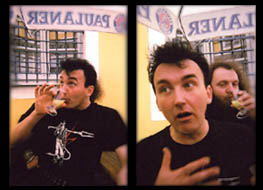 otherwise
normal shopping street, offers 80 different varieties of the green fairy,
and even in the early morning it's crowded with goths chucking the stuff
down their necks. The barman brings a selection of ten to our table in
the courtyard, rather frighteningly decanted into test tubes. Purely in
the interests of scientific research, it's all swigged down, and although
we're only taking small sips it's still possible to feel the effects. Absinthe,
to me, is a bit like drinking crushed aniseed balls, those noxiously over-sweet
confections which used to be sold in traditional British sweet shops. It's
a nice novelty, but I think I'll stick to beer.
otherwise
normal shopping street, offers 80 different varieties of the green fairy,
and even in the early morning it's crowded with goths chucking the stuff
down their necks. The barman brings a selection of ten to our table in
the courtyard, rather frighteningly decanted into test tubes. Purely in
the interests of scientific research, it's all swigged down, and although
we're only taking small sips it's still possible to feel the effects. Absinthe,
to me, is a bit like drinking crushed aniseed balls, those noxiously over-sweet
confections which used to be sold in traditional British sweet shops. It's
a nice novelty, but I think I'll stick to beer.
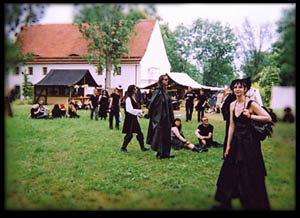 There's
still a few hours to go before the bands start up, so we investigate the
medieval village, tucked away in some parkland behind the campsite. Medievalism
(if that's the right word) is big in Germany. Living your life like it's
1350 is a subculture all of its own. Here, there's a blacksmith hammering
molten metal into strange shapes, and a stall selling potent fruit wine,
which can also result in some strange shapes if you try to walk after a
couple of bottles. It's a relaxing, if rather incongruous, pastoral scene,
as goths, in all their varied styles and hairdos, spread themselves out
over the grass while an affable bearded fellow demonstrates Saxon woodcarving,
and smoke from the wood-burning stoves of the food stalls curls its way
into the air.
There's
still a few hours to go before the bands start up, so we investigate the
medieval village, tucked away in some parkland behind the campsite. Medievalism
(if that's the right word) is big in Germany. Living your life like it's
1350 is a subculture all of its own. Here, there's a blacksmith hammering
molten metal into strange shapes, and a stall selling potent fruit wine,
which can also result in some strange shapes if you try to walk after a
couple of bottles. It's a relaxing, if rather incongruous, pastoral scene,
as goths, in all their varied styles and hairdos, spread themselves out
over the grass while an affable bearded fellow demonstrates Saxon woodcarving,
and smoke from the wood-burning stoves of the food stalls curls its way
into the air.